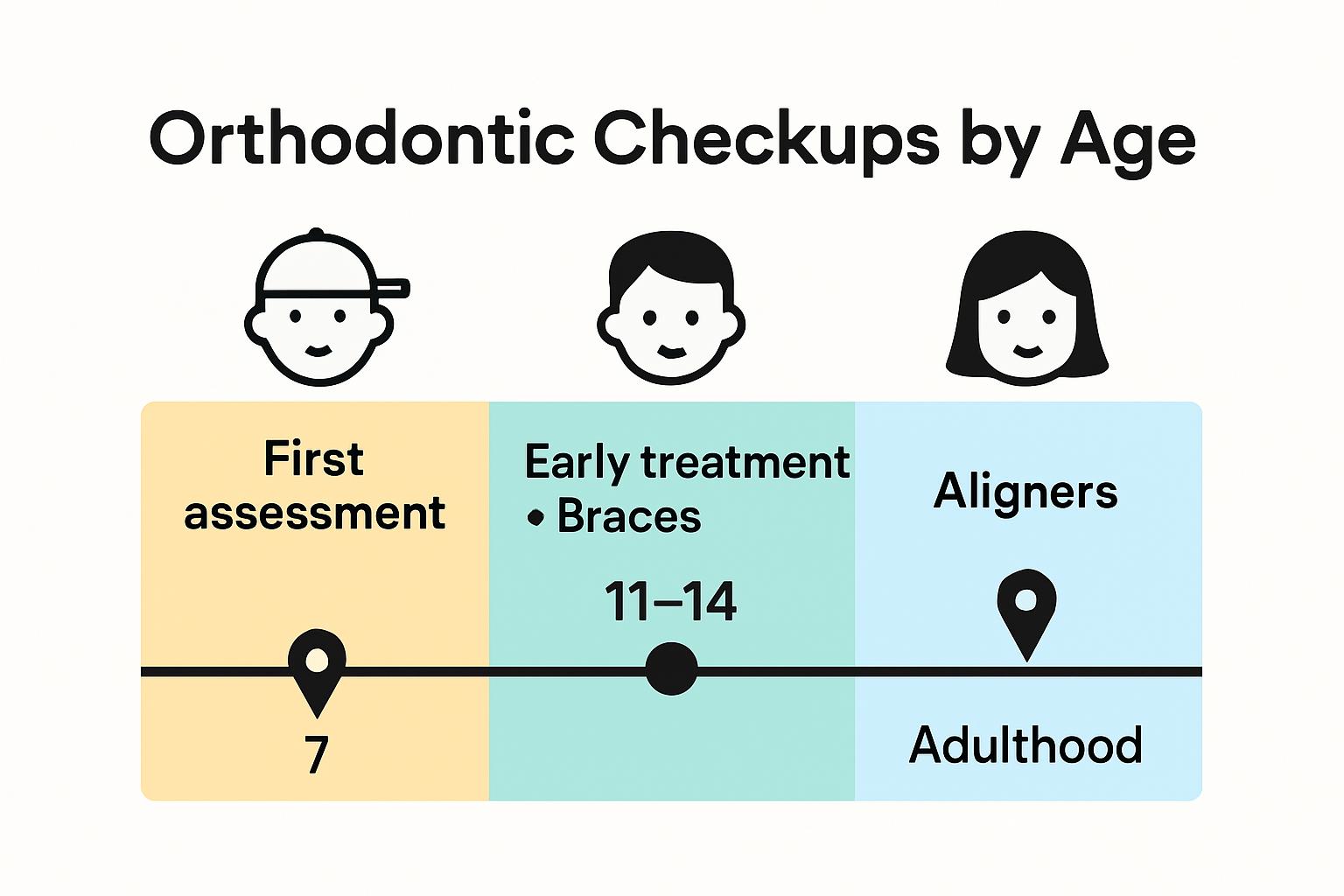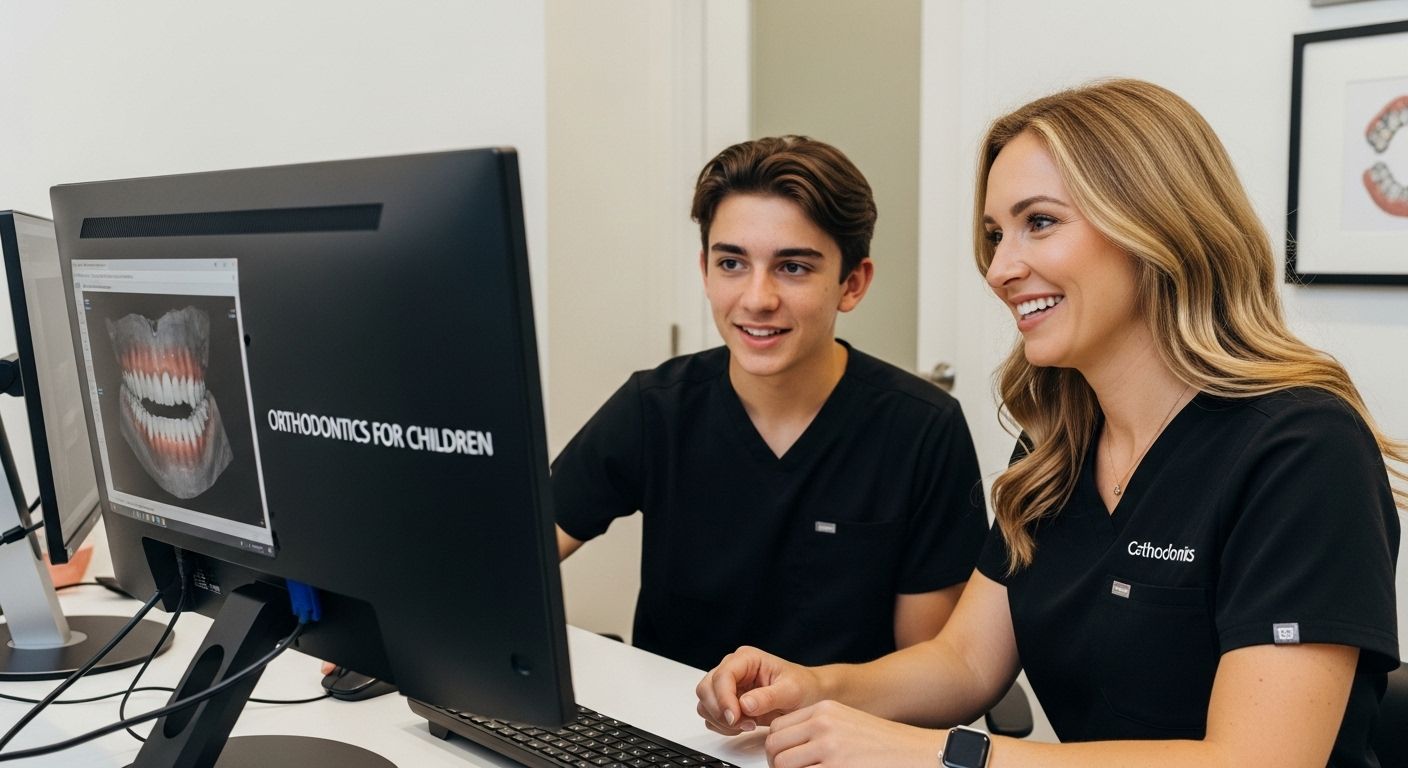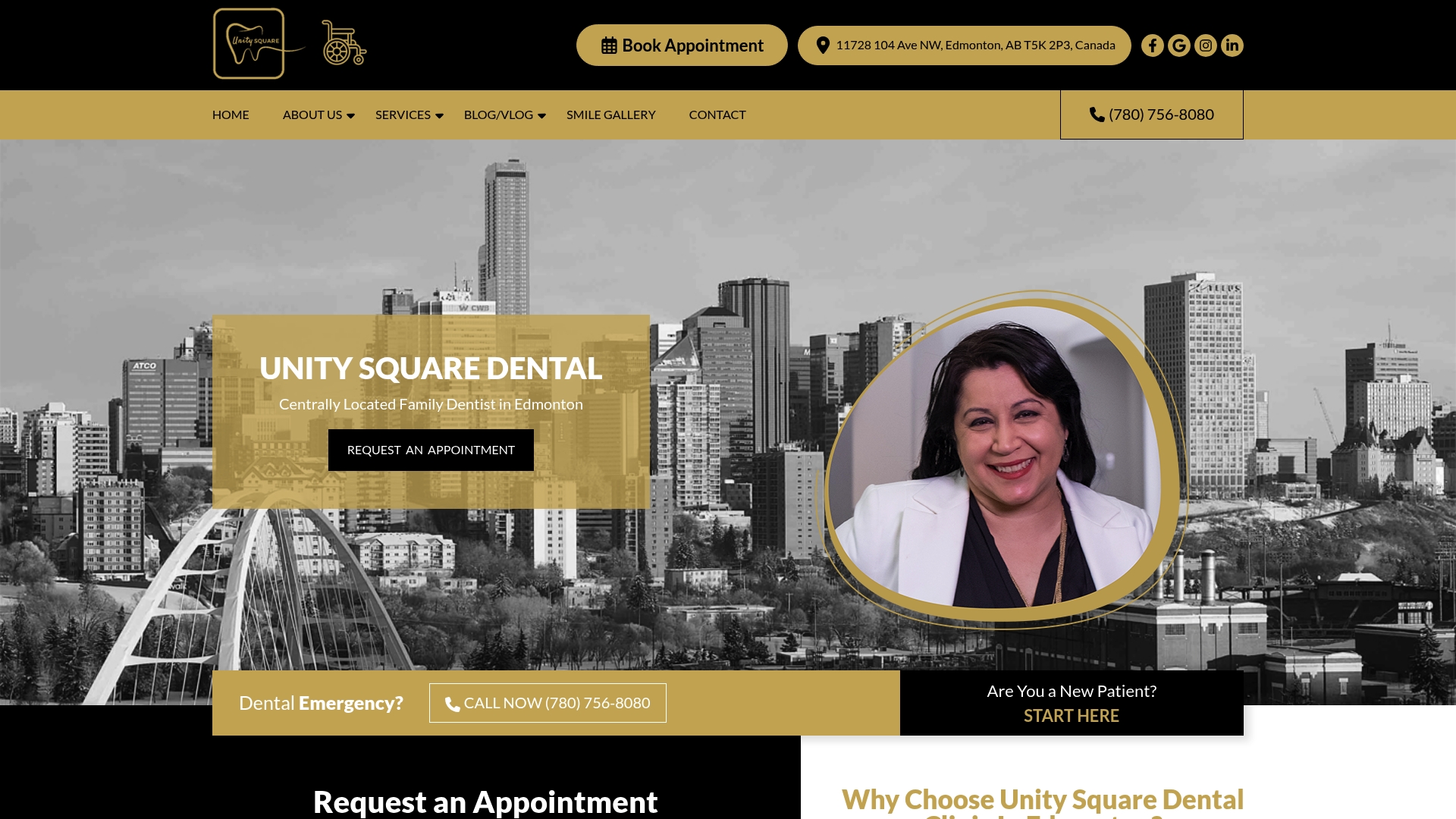
Parents everywhere wonder about the best moment to start orthodontic treatment for their kids. Most expect the answer to be during the teenage years but professional guidance suggests something very different. Experts actually recommend the first orthodontic checkup by age 7 which can spot issues early, long before braces even cross your mind.
Table of Contents
- Understanding When To Start Orthodontic Care
- Orthodontics For Children, Teens, And Adults
- Special Considerations For Comfort And Accessibility
- Choosing The Right Edmonton Orthodontic Provider
Quick Summary
| Takeaway | Explanation |
|---|---|
| Start evaluations by age 7 | Children should receive their first orthodontic assessment by age 7 to identify potential issues early, aiding future treatment plans. |
| Optimal treatment window is 8-14 years | The best age range for most orthodontic interventions is between 8 and 14 when children’s bones are still growing, allowing for effective treatment. |
| Consider comfort and emotional support | Orthodontic treatment causes anxiety; addressing comfort and emotional well-being is crucial for patients of all ages. |
| Choose a qualified orthodontic provider | Selecting an orthodontist with proper credentials and up-to-date technology ensures high-quality, personalized care for optimal dental outcomes. |
| Include accessibility in care discussions | Ensure that orthodontic practices accommodate diverse patient needs, creating a supportive environment for all individuals seeking treatment. |
Understanding When to Start Orthodontic Care
Deciding the right time for orthodontic treatment requires careful consideration of multiple factors that impact dental development and overall oral health. Parents often wonder about the optimal moment to initiate orthodontic care for their children, seeking guidance that balances medical expertise with individual developmental needs.
Early Detection and Assessment
The journey toward optimal dental alignment begins earlier than most parents expect. According to the American Association of Orthodontists (AAO), children should have their first orthodontic evaluation by age 7. This recommendation stems from a critical period when a child’s mouth contains a mix of baby and permanent teeth, allowing orthodontists to identify potential alignment issues before they become more complex.
During this initial assessment, orthodontic professionals look for several key indicators that might suggest future treatment requirements. These include crowded teeth, unusual spacing, bite misalignments, and potential jaw growth irregularities. Early detection does not necessarily mean immediate treatment but provides valuable insights into potential future interventions.

Age Range for Orthodontic Interventions
Research from Johns Hopkins Medicine suggests the ideal age range for orthodontic treatments is between 8 and 14 years. This window coincides with significant dental transitions, making it optimal for addressing alignment challenges. During these years, children’s bones are still growing, which allows for more responsive and potentially less invasive treatments.
The timing of orthodontic care depends on individual developmental factors. Some children might benefit from interceptive treatments as early as 6 or 7, while others might not require intervention until their early teenage years. Factors influencing this decision include jaw growth patterns, tooth eruption sequence, and potential genetic predispositions to dental misalignments.
Personalized Treatment Planning
Every child’s dental journey is unique, which means there is no universal “perfect” age for orthodontic care. Professional evaluations consider multiple aspects beyond chronological age. Orthodontists assess skeletal maturity, dental development, bite relationship, and potential future growth patterns. A study published in PubMed highlighted that systematically planned early treatments can significantly reduce the complexity of future orthodontic interventions.
Parents seeking comprehensive guidance should schedule a professional consultation. At Unity Square Dental, we provide thorough assessments for pediatric dental care that help families make informed decisions about their children’s orthodontic needs. Our approach combines advanced diagnostic techniques with personalized treatment strategies, ensuring each child receives care tailored to their specific developmental trajectory.
Remember that proactive monitoring and timely professional evaluations are key to maintaining optimal dental health and achieving the best possible orthodontic outcomes for your child.
Orthodontics for Children, Teens, and Adults
Orthodontic treatment is not confined to a single age group. Each life stage presents unique opportunities and challenges for dental alignment, requiring specialized approaches that address individual needs and developmental characteristics.
Pediatric Orthodontic Considerations
According to the American Association of Orthodontists, early orthodontic evaluations can identify potential dental issues before they become complex problems. Children between ages 7 and 11 represent a critical window for interceptive orthodontic interventions. During this period, orthodontists can guide jaw growth, create space for emerging permanent teeth, and address potential alignment challenges proactively.
Interceptive treatments might include spacers, partial braces, or specialized appliances that help correct developing misalignments. These early interventions can reduce the complexity and duration of future orthodontic treatments, potentially minimizing more invasive procedures later in life.
Teenage Orthodontic Transformations
The American Dental Association highlights that teenage years represent the most common period for comprehensive orthodontic treatment. Most teens have a full set of permanent teeth, making this an ideal time for comprehensive alignment corrections. Teenagers typically experience rapid growth and development, which can be advantageous for orthodontic interventions.
Modern orthodontic solutions offer teenagers multiple treatment options beyond traditional metal braces. Clear aligners, ceramic braces, and lingual braces provide aesthetic alternatives that address alignment issues while maintaining a natural appearance. These options can significantly improve teens’ confidence during a sensitive developmental period.
Adult Orthodontic Solutions
Contrary to popular belief, orthodontic treatment is not exclusively for children and teenagers. Adults can successfully pursue dental alignment at any age, provided they maintain good overall oral health. Many adults seek orthodontic care to address long-standing alignment issues, improve dental functionality, or enhance aesthetic appearance.
Adult orthodontic treatments often require more nuanced approaches. Factors like reduced bone plasticity, potential periodontal concerns, and complex medical histories necessitate personalized treatment plans. Clear aligners have become particularly popular among adults, offering discreet and flexible orthodontic solutions that accommodate professional and social environments.
At Unity Square Dental, we provide comprehensive orthodontic care tailored to each life stage. Our approach recognizes that dental alignment is a lifelong journey, with unique considerations for children, teens, and adults. We leverage advanced diagnostic technologies and personalized treatment strategies to help patients achieve optimal dental health and confidence.
Regardless of age, successful orthodontic treatment requires professional assessment, patient commitment, and a holistic understanding of individual dental development.
Here’s a summary table comparing the unique considerations, treatment types, and benefits for orthodontic care at different life stages. This helps readers quickly understand the differences between pediatric, teen, and adult orthodontic treatment.
| Life Stage | Key Considerations | Common Treatments | Unique Benefits |
|---|---|---|---|
| Children (7-11) | Early detection, interceptive interventions | Spacers, partial braces, appliances | Guides jaw growth, creates space, prevents complex issues |
| Teens (12-18) | Full permanent teeth, rapid growth | Traditional braces, clear aligners, ceramic/lingual braces | Comprehensive corrections, aesthetic options, boosts confidence |
| Adults (18+) | Bone maturity, periodontal history, aesthetics | Clear aligners, braces (tailored) | Discreet options, addresses long-standing issues |

Special Considerations for Comfort and Accessibility
Orthodontic treatment extends far beyond technical procedures, encompassing critical aspects of patient comfort, emotional well-being, and individual accessibility needs. Understanding these nuanced considerations ensures that orthodontic care remains inclusive, supportive, and responsive to diverse patient requirements.
Patient Anxiety and Emotional Support
Orthodontic treatments can trigger significant anxiety for patients across all age groups. Children, teenagers, and adults may experience apprehension about potential discomfort, appearance changes, and the treatment process itself. Professional orthodontic practices must create environments that prioritize psychological comfort alongside physical treatment.
Strategies for managing patient anxiety include clear communication, step-by-step procedure explanations, and creating welcoming, non-intimidating clinical spaces. Gentle approaches that respect individual emotional responses can transform potentially stressful experiences into positive healthcare interactions. Research from the National Institutes of Health emphasizes that early intervention and compassionate care can significantly reduce treatment complexity and patient stress.
Accessibility and Inclusive Design
True orthodontic excellence requires comprehensive accessibility that addresses physical, sensory, and cognitive diversity. Our commitment to inclusive dental care means creating treatment environments adaptable to patients with varying mobility, communication, and sensory processing needs.
Accessibility considerations include wheelchair-friendly facilities, communication alternatives for patients with hearing impairments, visual guides for patients with cognitive differences, and flexible scheduling that accommodates diverse work and personal requirements. These adaptations ensure that high-quality orthodontic care remains available to all community members, regardless of individual physical or neurological characteristics.
Technology and Personalized Comfort
Advanced orthodontic technologies play a crucial role in enhancing patient comfort and treatment precision. Digital scanning technologies eliminate traditional uncomfortable impression methods, providing more accurate and less invasive diagnostic processes. 3D imaging allows for personalized treatment planning that minimizes unnecessary interventions and reduces overall treatment duration.
Modern orthodontic solutions like clear aligners offer increased aesthetic discretion and comfort compared to traditional braces. These innovations allow patients to maintain confidence during treatment while experiencing minimal lifestyle disruption. Customized treatment approaches consider individual pain thresholds, ensuring that interventions are tailored to personal comfort levels.
At Unity Square Dental, we recognize that exceptional orthodontic care transcends technical expertise. Our approach integrates advanced medical knowledge with compassionate, patient centered practices. We understand that every individual’s orthodontic journey is unique, requiring personalized strategies that respect emotional, physical, and practical considerations.
Our goal is not just dental alignment but holistic patient well-being, creating treatment experiences that are comfortable, accessible, and empowering for every individual who walks through our doors.
Choosing the Right Edmonton Orthodontic Provider
Selecting the right orthodontic provider is a critical decision that impacts not just dental alignment but overall oral health and patient experience. Edmonton families deserve comprehensive, personalized care that combines advanced technology, professional expertise, and compassionate treatment approaches.
Credentials and Professional Qualifications
The foundation of exceptional orthodontic care rests on professional credentials and specialized training. Families should prioritize providers who are members of recognized professional associations such as the Canadian Association of Orthodontists. These memberships indicate rigorous educational standards, ongoing professional development, and commitment to ethical practice.
Key qualifications to investigate include board certification, specialized orthodontic training beyond general dentistry, and continuous education in emerging orthodontic technologies. Research shows that providers who maintain active professional development demonstrate more advanced treatment techniques and stay current with innovative orthodontic solutions. Look for orthodontists who have completed accredited postgraduate programs specifically focused on orthodontic and dentofacial orthopedic treatments.
Technology and Treatment Approach
Modern orthodontic care demands sophisticated diagnostic and treatment technologies. When selecting a cosmetic dental provider, families should evaluate the clinic’s technological capabilities. Advanced 3D imaging, digital scanning, and computer-assisted treatment planning represent significant improvements over traditional orthodontic methods.
Comprehensive treatment approaches should include:
- Detailed initial consultations with comprehensive oral assessments
- Personalized treatment planning considering individual dental anatomy
- Multiple treatment options tailored to patient needs
- Clear communication about expected outcomes and potential challenges
A forward-thinking orthodontic provider demonstrates flexibility in treatment modalities, offering solutions ranging from traditional braces to innovative clear aligner technologies. The ability to adapt treatment strategies to individual patient requirements indicates a patient-centered approach.
Patient Experience and Support
Beyond technical expertise, the patient experience defines the quality of orthodontic care. Exceptional providers create supportive environments that address not just dental mechanics but patient comfort, anxiety management, and long-term oral health strategies.
Critical factors in evaluating patient experience include:
- Transparent pricing and flexible payment options
- Comprehensive initial and follow-up consultations
- Accessible communication channels
- Supportive staff trained in patient care and emotional support
- Flexible scheduling accommodating diverse patient needs
Parents and patients should feel empowered to ask detailed questions about treatment protocols, expected timelines, potential challenges, and post-treatment care. A reputable orthodontic provider will welcome thorough inquiries and provide clear, comprehensive responses.
At Unity Square Dental, we understand that choosing an orthodontic provider is more than a medical decision—it’s a commitment to your family’s long-term oral health and confidence. Our approach combines advanced professional expertise, cutting-edge technology, and compassionate patient care, ensuring that every individual receives personalized, high-quality orthodontic treatment.
The following table outlines key factors to consider when choosing an orthodontic provider, summarizing what to look for in credentials, technology, and patient experience.
| Factor | What to Look For | Why It Matters |
|---|---|---|
| Credentials | Board certification, association memberships, specialized training | Indicates expertise and ethical standards |
| Technology | 3D imaging, digital scanning, advanced equipment | Enables precise diagnostics and effective care |
| Treatment Approach | Personalized plans, multiple options, clear communication | Adapts to patient needs and preferences |
| Patient Support | Compassionate staff, flexible scheduling, transparent pricing | Enhances comfort and satisfaction |
Remember, the right orthodontic provider is a partner in your dental health journey, committed to achieving not just straight teeth, but a lifetime of confident, healthy smiles.
Frequently Asked Questions
What is the best age for a child to have their first orthodontic evaluation?
The American Association of Orthodontists recommends that children receive their first orthodontic evaluation by age 7. This allows for early detection of potential alignment issues before they become more complex.
What age range is optimal for most orthodontic treatments?
The optimal age range for most orthodontic interventions is between 8 and 14 years, during which time children’s bones are still growing, making treatments more effective.
Why is early orthodontic treatment important?
Early orthodontic treatment can guide jaw growth, create space for emerging teeth, and address alignment challenges proactively, ultimately reducing the complexity of future treatments.
Can adults receive orthodontic treatment, and what options are available?
Yes, adults can successfully pursue orthodontic treatment at any age. Common options include clear aligners and traditional braces, which can address long-standing alignment issues discreetly.
Secure the Best Start: Personalized Orthodontic Care for Your Family in Edmonton
Are you concerned about missing the critical window for your child’s orthodontic care? Early orthodontic evaluations and timely treatment planning, as explored in our expert guide, can make a significant difference in your child’s oral health and confidence. Many families in Edmonton share concerns about identifying the right age for braces and finding a dental team that offers both advanced technology and gentle, personalized support. At Unity Square Dental, we make it easy to take control of your family’s dental future, providing a comfortable environment, professional assessments, and accessibility for every patient, including flexible scheduling and weekend appointments.

Put your child’s smile on the best path today. Act on the guidance from our article and book an early orthodontic evaluation with our trusted team. Discover more about our commitment to advanced care, patient comfort, and transparent service by visiting Unity Square Dental or explore our Patient Gallery to see real results. Your child’s healthy and confident smile begins with one click. Book your appointment now.
Recommended
- How Often to Visit Dentist in Edmonton: 2025 Family Guide – Unity Square Dental
- How to Find a New Dentist in Edmonton: Tips for 2025 – Unity Square Dental
- Is Teeth Whitening Safe? 2025 Edmonton Family Guide – Unity Square Dental
- Oral Hygiene for Braces: Edmonton Family Guide 2025 – Unity Square Dental

